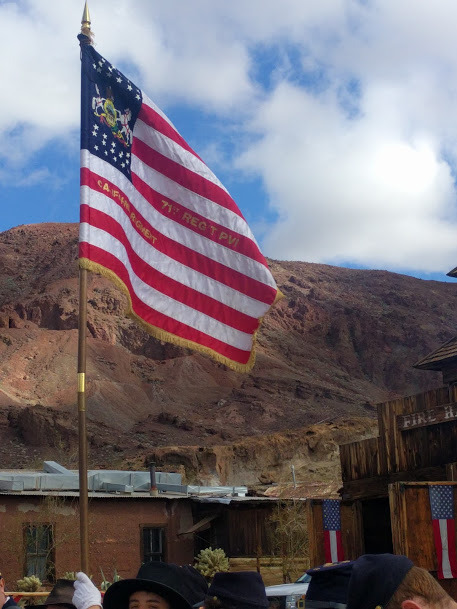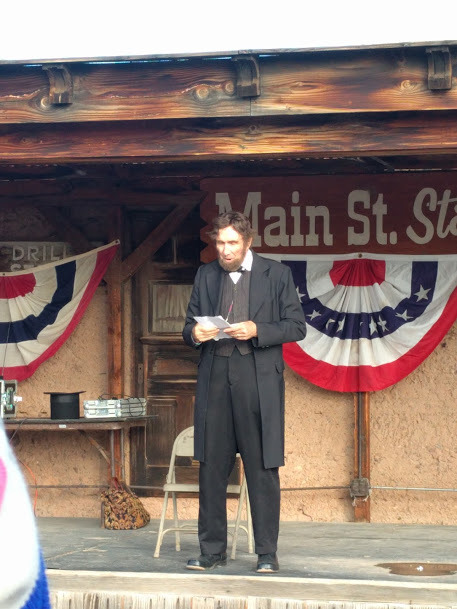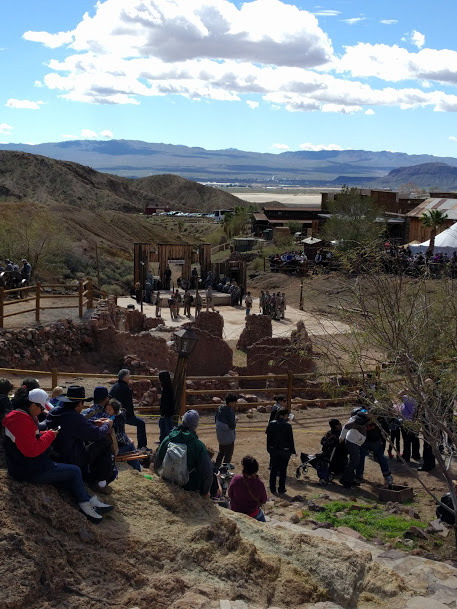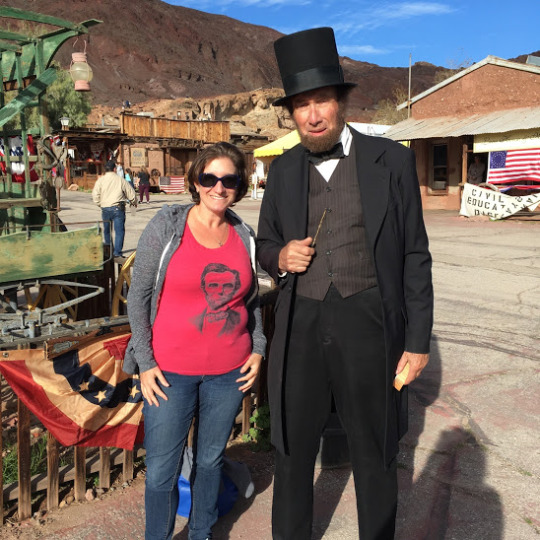Text
Blue and Gray in California
When I was in grad school explaining whatever project I was working on at the time, I had a spiel that went something like this: “When you learn California state history in fourth grade,it’s pretty much missions and the gold rush, and you don’t really go too far beyond that.” And then I would proceed to discuss whatever my current project was and how it was intended to expand on California history and tie it to a national narrative. This was particularly true of my capstone project, which was half of an exhibit on the Civil War and the civil rights movement. I curated the Civil War portion. I was born and raised in California and when my professor pitched the Civil War in California to me, I was genuinely confused as to what he was talking about. (My entire education has taken place in California). The Civil War was something that happened “back there.” So nothing that I saw at Calico this weekend surprised me, but I continue to be disappointed that given the opportunity to teach audiences about local history, these sites pass.
Let’s start with the fact that it’s not entirely clear to me why a silver mining town founded in 1881 has a Civil War weekend. It appears to be because there is a circuit for these things and Calico is on that circuit. Calico is just east of Barstow, Ca, about half way between Orange County, Ca and Las Vegas. So most visitors have either traveled a bit to get there, or are making a pit stop between southern California and Vegas.
http://cms.sbcounty.gov/parks/Parks/CalicoGhostTown.aspx
This is the extent of the California Civil War at Civil War Days.
California Regiment Flag:

And this is the crux of my disappointment. This particular place is not bound by any connection to the event, so they can portray whatever Civil War history they would like, so why not take the opportunity to discuss California’s unique connections to this event. The Civil War didn’t just happen “back there!” First, California statehood reignited the debate over slavery and the expansion of slavery that had been taking place throughout the history of the US. Second, there is a Civil War military installation less than 150 miles from Calico that was established because of the confederate sympathizers in Los Angeles! Third, there were many crazy plots to steal the gold that was largely funding the war effort. Could these things not have been discussed among generic civil war battles and Mary Todd Lincoln’s reminiscences (more on that later) and Lincoln’s reading of the Gettysburg Address? Because here’s the thing! All of those things are important. Which brings me back to my earlier point. Californians have made unique contributions to many of the important events in our nation’s history. These contributions are part of the national narrative and local history sites should take the opportunity to represent the people and events that tie California to our nation’s history.
Lincoln Interpreter reading/reciting the Gettysburg Address:

Okay, clearly I have a lot of thoughts on the local history snub.
What did I think about the event that did take place? We first visited the Union encampment. This made me wonder how dedicated to authenticity these events should try to be. I am on the record as feeling very strongly that even pretending authenticity can be achieved is a fool’s errand and to claim authenticity can be achieved is unrealistic and harmful. That said, I do think that trying to eliminate obvious anachronisms is a reasonable goal. That’s why the bananas caught my attention. I have now spent about five minutes researching bananas in 19th century America and based on that, it seems highly unlikely they would have had bananas in a Civil War camp, but if someone wants to correct me on this, let me know. This is more something that makes me giggle, not a grave history sin!

Same with the man on the cell phone here. Also, this is me holding a legit Civil War bayonet. It could have been mine for $220, so I just chose to hold it and then get on with my day.

I am serious about the next statement. Trying hardtack was my favorite part of the event. My fascination with the Civil War started in fifth grade. I have read a lot about hardtack, I have visited more battlefields than I can list here. Hardtack is something that one comes across frequently when learning about soldiers, rations, life in the camp. I have read many descriptions, but I had never tried it. So when I saw they were selling it, I had to buy a piece. The guys in the sutlery warned me not to try to eat the hardtack dry (which I already knew, but also, of course I tried to nibble on it because I had to understand just how hard it was. It’s really hard.) I threw the hardtack in my purse until I could buy a cup of hot tea. And once it soaked long enough, I tried it! It tastes like an extremely hard, thick saltine cracker.

This is a really important point! People make connections to history in unexpected ways. I have a confession to make. I go to a lot of battlefields (French and Indian War, Revolutionary War, the War of 1812, the Civil War), and I’m never 100% sure how I am supposed to feel. This gets back to the issue of authenticity. These places are so far removed from the death and carnage that existed there, that the connection feels very elusive to me. But the hardtack was a concrete (ha!) connection for me. And I really felt like I learned something when I tossed it in my purse, saved it for later and struggled with figuring out how long I had to soak it before I could even bite a small corner off.
One of the other slightly odd presentations was a short play about Mary Todd Lincoln where she talked about her experience being committed to an insane asylum by her oldest son, Robert. It was introduced by a group that does, ���education through entertainment” by presenting, “what happened in the past or what might have happened in the past.” First, the Lincoln interpreter attended the show, so that was a little weird. Maybe at least take off the hat, and try to be a little more incognito.
This presentation was a little uncomfortable for me because, as far as I can tell, Mary Todd Lincoln never spoke or wrote about this experience so to invent this out of whole cloth did sit quite right with me. I think it’s okay to take dramatic license to present what might have happened in the past, but this should be grounded in some facts, and this didn’t seem to be. So we are back to the question of authenticity and how authentic these events should be. I don’t think there’s a firm answer here, but it’s an issue I will continue to discuss and wrestle with throughout this project.
And what would a Civil War weekend be without a discussion of battles. My biggest issue here was that it completely lacked any context or information about that battle. I’ll be upfront about my bias. I’m not a fan of battle re-enactments. I have issues with playing with guns and pretending to shoot people, but I will grant that done properly, they can be educational. I also think artillery demonstrations are different. I’ve been to a few and they are very information and interesting. These battles were not done well.
Battle #1 takes place on a stage in the middle of actual ruins from Chinatown.

I went into this wondering if they were re-enacting a particular battle or if this was a generic battle. Based on the lack of information about a specific battle, I think it was generic. So is there educational value here or is this just theater? It’s probably obvious by now that I think that the goal of this event (all of it, not just the battle), should be entertainment and education. Am I projecting my own values on this event? I don’t think so. At the beginning of the event, when we were in the banana camp, a lady was there with two high school aged foreign exchange students. She told a re-enactor that they were there to learn about the Civil War and he proceeded to explain it, so I don’t think I’m alone in expecting this to be an educational event. I don’t think it succeeded as such. I know a fair amount about the war and I didn’t really learn anything new (except my first-hand knowledge on the durability of hardtack). If you went into that event knowing nothing about the war, I’m not sure you would have left having any information that would serve you well in a high school level US history course.
I could go on and on and on, but I think I’m going to end it here, with a picture with Abe. And now I’m thinking the Drum Barracks needs to be my next stop!

1 note
·
View note
Text
Public History and California
First things first. I have never blogged before and I’m trying to think of a good hook here, but it’s not coming to me, so I’ll explain who I am and what I’m doing here. I got my Master’s in Public History almost six years ago. All of my work at Cal State Fullerton was focused on California history and more specifically, little known aspects of California history, such as Civil War history here in California. Once I graduated, I did some contract work and volunteer work in museums and at historic sites, but I haven’t written about history in more than three years. Which brings me here. Last month, I was driving home from Northern California, passing a lot of signs for historic sites and it reminded me how much I love California and thinking and writing about the way that historic sites “do” history. I’m going to spend some time traveling around the state visiting these sites and writing about them. This is not going to be super academic, it’s more about my perspective as a visitor, who also has a background in public history. My first trip is to Civil War Days at Calico, so stay tuned!!
1 note
·
View note